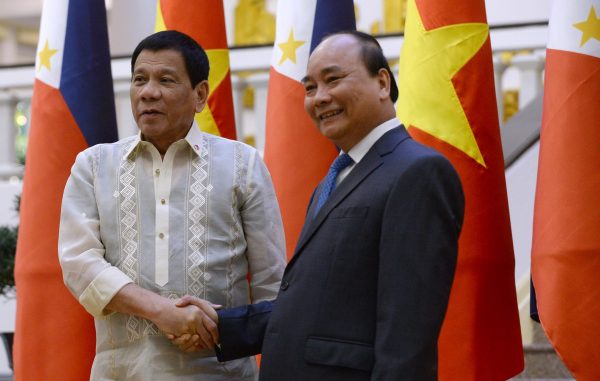But little more than six months after the establishment of the strategic partnership, the Philippines elected Rodrigo Duterte as the country’s next president. In a stark departure from his predecessor’s approach — and against the backdrop of Manila’s legal victory over Beijing in the SCS — Duterte announced that he would distance the Philippines from Washington and steer the country closer to China. The SCS issue was effectively placed on the backburner.
Strategic partnership is an arrangement either for ‘mutual benefit, based on shared values and interests’ or ‘mutual management, driven by a desire to put in place arrangements to help manage rivalry over values or interests’. The overlapping claims of Manila and Hanoi in the SCS combined with their shared concern about Beijing’s geopolitical ambitions in the region suggest that the Philippines–Vietnam strategic partnership is arguably an arrangement for both mutual benefit and mutual management. Indeed, the statement establishing the strategic partnership articulates the two countries’ shared goal of promoting freedom of navigation and overflight, as well as their commitment to handle differences in the SCS in a friendly and constructive manner.
The Duterte government appears to place more emphasis on the mutual management dimension of the strategic partnership. After his 2016 visit to Vietnam, Duterte personally led the sending off ceremony for 17 Vietnamese fishermen who were released after charges of poaching and illegal entry to the Philippines were dropped.
In September 2017, an encounter with the Philippine Navy that led to the death of two Vietnamese fishermen caused friction between the two strategic partners. Following bilateral talks with Vietnamese President Tran Dai Quang at the sidelines of the APEC summit in November 2017, Duterte apologised for the incident and again led the sending off ceremony for the five crewmates of the slain fishermen following their release.
The Duterte administration is continuing some of the strategic partnership’s confidence-building measures too. These include military interaction in Southwest Cay — previously occupied by Manila and now under Hanoi’s control — where officers from both countries play sports and share information on topics like maritime security. The Vietnamese Navy’s Le Quy Don 286 also docked at the Manila South Harbor in April 2017 for a goodwill visit.
But the 2017 Philippine chairmanship of ASEAN under Duterte did present some challenges to the strategic partnership’s objective of maintaining stability in the SCS. Under Manila’s leadership, the Chairman’s Statements for the 30th and 31st ASEAN Summits did not explicitly mention land reclamations in the SCS — reportedly due to pressure from China.
By contrast, the Philippines had led the diplomatic push with Vietnam for a strong ASEAN statement to condemn Beijing’s creation of artificial islands during the previous Aquino administration.
When Vietnam successfully lobbied for the mention of SCS land reclamations in the 50th ASEAN Foreign Ministers’ Meeting Joint Communique, Philippine Foreign Secretary Alan Peter Cayetano admitted that Manila’s official position was to not mention the issue. Cayetano described the communique as ‘not reflective’ of the present situation because Beijing is ‘not reclaiming land anymore’. Satellite images appear to suggest otherwise.
Early in the Duterte administration, the Philippines appeared to pursue a hedging strategy between the United States and China. Recent events suggest that Manila is now gravitating towards a closer geopolitical confluence with Beijing.
In January 2018, Manila confirmed that it had granted Beijing’s request to conduct ‘maritime research’ in Benham Rise. The following month, Duterte argued that the Philippines should not be threatened by Beijing-constructed military facilities in the SCS — some of which are built in Manila’s claimed territory — because they are ‘intended against those who the Chinese think would destroy them and that is America’. The Duterte administration has also called on China in the past to conduct maritime patrols in the Sulu Sea.
This shift in Manila’s foreign policy towards closer relations with China may prove to be a challenge to the strategic rationale and objectives of the Philippines–Vietnam strategic partnership.
Mindful of how its actions might look to Vietnam, Manila has attempted to reassure Hanoi. At the sidelines of the 32nd ASEAN Summit in April 2018, Duterte conveyed to Vietnamese Prime Minister Nguyen Xuan Phuc that Manila is not abandoning its legal victory against Beijing.
The regional security environment in Asia remains fluid. Political developments, international or domestic, may trigger Manila to recalibrate its foreign policy. If this were to arise, the Philippines–Vietnam strategic partnership and the opportunities for bilateral information exchange that it provides may enable and encourage Manila to emulate aspects of Hanoi’s approach in the SCS.
As former Philippine national security adviser Roilo Golez stressed, Vietnam is pursuing ‘a very skilful diplomatic offensive’ while at the same time enhancing its defence capabilities in the SCS — something from which the Philippines can learn.
Mico A Galang is a researcher at the National Defense College of the Philippines (NDCP). The views expressed are of the author’s alone and do not necessarily reflect the official position of the NDCP.

